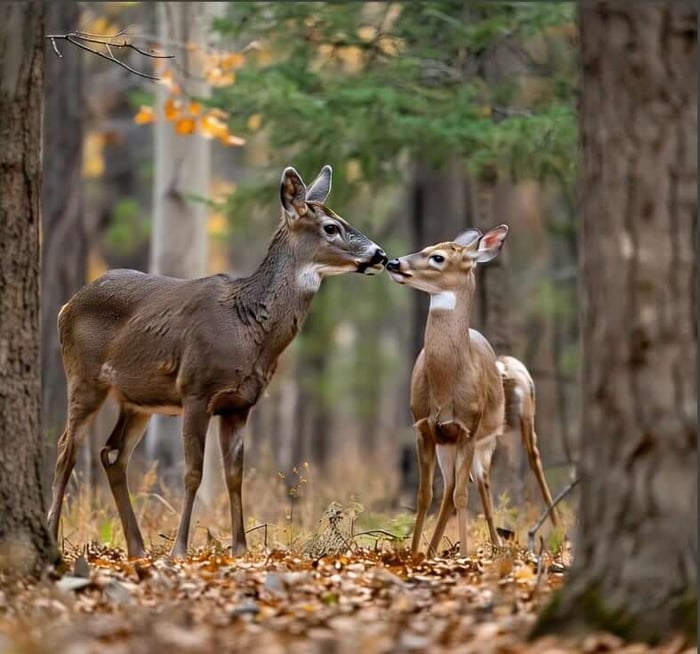In deer hunting or simply wildlife watching, the mule deer and whitetail conversation is one that raises eyebrows among nature buffs and outdoor enthusiasts. Both mule deer and whitetail deer are symbols of American and Canadian landscapes, but they have distinctions that influence how hunters, wildlife enthusiasts, and even casual onlookers engage with them. In this article, we’ll break down the mule deer and whitetail comparison in simple, human-like language, diving into their physical traits, habitats, behaviors, and more. By the end, you’ll have a clear understanding of the deer distinctions and feel confident discussing them Mule Deer vs Whitetail Let’s jump in!
What Is the Mule Deer vs Whitetail Difference? A SimpleMule Deer vs Whitetail Overview
At first glance, mule deer and whitetail deer might seem similar—they’re both deer, after all. But the mule deer-whitetail comparison reveals distinct differences that set them apart. Mule deer (Odocoileus hemionus) and whitetail deer (Odocoileus virginianus) belong to the same genus, but their physical features, habitats, and behaviors make them unique. Think of it like comparing two cousins: they share some traits but have their own personalities.
The mule deer-whitetail differentiation is important for hunters, who must understand what species they're following, and wildlife observers, who wish to enjoy their behaviors. Let's look at the most important differences in depth.
Defining Mule Deer
Mule deer, sometimes referred to as "muleys," take their name from their big, mule-like ears that are prominently displayed. They're located primarily in the western United States, Canada, and Mexico. Mule deer are renowned for their ability to thrive in challenging landscapes, from deserts to mountains. The mule deer and whitetail comparison is an interesting one due to their distinctive features.
Some of the most prominent features of mule deer are:
Large Ears: Their large ears assist with hearing and temperature control.
Antlers: Mule deer antlers branch outward, dividing into several tines instead of branching from the main beam.
Body Size: They're more muscular, with a stronger build, usually weighing 150–300 pounds.
Movement: Mule deer travel with a characteristic "stotting" gait, bouncing on all four legs when startled.
Defining Whitetail Deer
Whitetail deer, or "whitetails," get their name from the white underpart of their tail, which they display when alarmed. They're the most geographically widespread deer species in North America, ranging from Canada to South America. Whitetails live in a variety of habitats, from woods to fields. Knowing their characteristics is the most important part of the deer distinctions.
Some of the most important characteristics of Mule Deer vs Whitetail
Tail: Their white underbelly is accompanied by a large, bushy tail.
Antlers: Whitetail antlers branch off from a single main beam, with tines going upwards.
Body Size: They're leaner, usually around 100–200 pounds, although some bucks get bigger.
Movement: Whitetails bound when they run, zigzagging to avoid predators.
The mule deer vs whitetail differences in appearance and habits are obvious when you know where to look. Let's dive deeper into their differences.
Physical Differences in the Mule Deer vs Whitetail Comparison
The deer distinctions debate usually begins with their physical characteristics, which are the simplest to identify. Here's a closer examination of how they compare in appearance.
Antlers
One of the most visible characteristics of the comparison between mule deer and whitetail is the antlers. Mule deer possess forked antlers that split into two or more tines that branch further, a "Y" shape. It provides their racks with a spread-out, broader appearance. Whitetail antlers, in contrast, develop from a main beam with tines branching off like fingers to form a more vertical, curved look. Antler shape is commonly used by hunters to identify their quarry in the mule deer vs whitetail controversy.
Ears and Face
Mule deer's huge, droopy ears are a giveaway. They use these 10-inch-long ears to catch predator sounds in open habitats. Whitetails possess smaller, more proportionate ears, which work better in thick forests where the sound carries differently. In the mule deer-whitetail differences, mule deer also have a darker forehead, whereas whitetails tend to have a lighter, more even face.
Body and Tail
Mule deer are more stout, with thicker bodies adapted to harsher habitats. Their tails are narrow and ropelike, frequently tipped with black. Whitetails are more gaunt, with a more streamlined physique, and their broad, bushy tails are brown on top and white on the bottom. Whitetails toss up their tail when they sense danger, exposing the white underside as a warning—a habit that's an important aspect of the deer distinctions.
Coloration
Both species have seasonal coat changes, but mule deer are grayer, which helps them blend into rocky or dry terrain. Whitetails are reddish-brown in summer and grayish-brown in winter, which allows them to blend into forests and fields. These color variations are slight but significant in the mule deer and whitetail observation for finding them in the wild.
Habitat and Range: Mule Deer vs Whitetail
Where these deer live is another important aspect of the mule deer-whitetail question. Their environments affect their behaviors and how hunters approach them.
Mule Deer Habitat
Mule deer are animals of the West, thriving in various scenarios such as:
Mountains: They are usually seen in Rockies, Sierra Nevada, and other mountain ranges.
Deserts: Mule deer adapt to dry lands like the Sonoran and Mojave Deserts.
Grasslands: They roam open prairies and sagebrush flats.
Their robust, open-terrain features make them a favorite among hunters in the mule deer and whitetail comparison. Mule deer prefer areas with sparse cover, where their large ears and stotting gait allow them to detect predators.
Whitetail Habitat
Whitetails are highly adaptable and can be found living in:
Forests: They do well in dense woodlands, where cover is plentiful.
Farmlands: Whitetails often feed in agricultural areas, especially around woodlots.
Suburban Areas: They’ve also learned to raid urban fringes, parks, and gardens.
This flexibility has made whitetails more prevalent in the eastern United States, Midwest, and southern Canada. Whitetails’ penchant for dense cover is the reverse of mule deer’s life in open country in the deer distinctions.
Overlap Zones
In some regions, such as the Great Plains or portions of the Southwest, whitetail and mule deer ranges overlap. In these locations, the mule deer vs whitetail differences become essential for hunters, as the rules usually vary for each species. Hybrids may be present in these areas, but they are uncommon and typically sterile.
Behavior and Habits: Mule Deer vs Whitetail
How these deer move is another critical aspect of the mule deer-whitetail comparison. Their behaviors affect hunting methods and wildlife observation.
Movement and Defense
Mule deer are renowned for "stotting," a hoppy, four-legged bounce used to cross rugged terrain and puzzle predators. They become more difficult to pursue on open terrain. Whitetails utilize speed and quickness, running through woods and zigzagging to get out of harm's way. Flashing white off their tail communicates alarm to other whitetails. These locomotive differences play a large role in the mule deer vs whitetail hunter’s debate in tracking their quarry.
Feeding Habits
Both species are herbivores, but their diets reflect their habitats. Mule deer graze on sagebrush, bitterbrush, and other tough plants found in arid regions. Whitetails prefer softer browse, like leaves, grasses, and crops such as corn and soybeans. In the mule deer and whitetail comparison, these dietary preferences affect where you’re likely to spot them.
Social Behavior
Mule deer are less territorial and tend to form loose groups in does and fawns. Bucks are solitary during the rut. Whitetails are more territorial and mark their grounds with scrapes and rubs. They also form tighter family groups. These social distinctions are subtle but significant in the mule deer-whitetail comparison to know their habits.
Hunting Considerations: Mule Deer and Whitetail
For deer hunters, the mule deer-whitetail choice is paramount, as both species need varying approaches and equipment.
Hunting Mule Deer
Mule deer hunting typically includes:
Spot-and-Stalk: Glassing open country with binoculars, then creeping on the target.
High Altitude: Many hunts take place in mountainous terrain, so physical conditioning is necessary.
Long Shots: Open environments for mule deer mean shots up to 200–400 yards, so rifles with strong range are essential.
Mule deer tags tend to be scarce and thus become an elusive trophy in the deer distinctions.
Hunting Whitetail Deer
Whitetail hunting typically entails:
Tree Stands or Blinds: Hunters occupy thick cover next to feeding regions or trails.
Close Range: Shots frequently are 50–150 yards, making shotgun or short-range rifle shots appealing in some venues.
Scouting: Reading whitetail tendencies, such as rubs and scrapes, is key.
Whitetails are more plentiful, but their skittishness makes them difficult. The mule deer-whitetail difference defines every detail of the hunt.
Conservation and Population: Mule Deer vs Whitetail
Both species have conservation issues, but their statuses vary in the mule deer and whitetail comparison.
Mule deer have decreased in certain western states because of habitat loss, severe winters, and predation. Conservation emphasizes the protection of winter ranges and migration corridors. Whitetails, on the other hand, have prospered, even to the point of overpopulating in certain regions, damaging crops, and causing automobile accidents. Controlled hunting often manages their numbers.
Conclusion: Why the Mule Deer vs Whitetail Debate Matters
In the mule deer and whitetail comparison, both deer are remarkable in their own right. Mule deer impress with their rugged adaptability and unique stotting gait, while whitetails captivate with their agility and widespread presence. Whether you’re a hunter, wildlife watcher, or nature lover, understanding the mule deer vs whitetail distinctions enhances your appreciation of these animals.
From their antlers to their habitats, the deer distinctions inform how we engage with them. The next time you're in the field, you'll know exactly which deer you're seeing—and why it matters. If you'd like to learn more about the mule deer-whitetail controversy or dive into detailed hunting tips, keep reading or talk to a local expert. The life of deer is one of magic, and the mule deer vs whitetail comparison is only the beginning!





